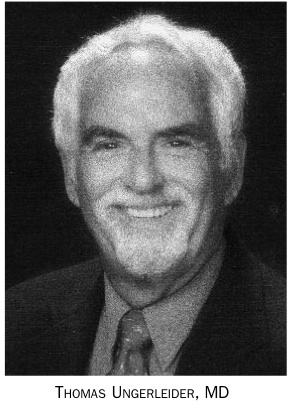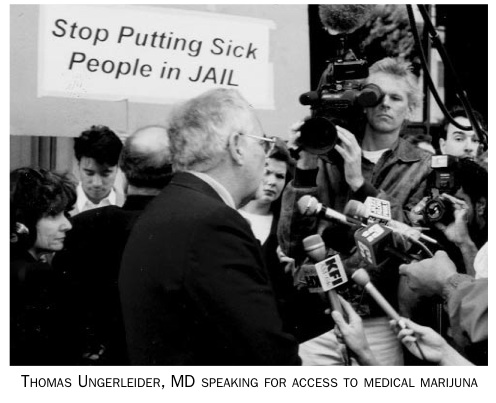First Appeared in CSAM NEWS - Spring 2004
A Tribute to Dr.Tom Ungerleider
Addiction as a Brain Disease:
What a Long Strage Trip It's Been
By David Smith, MD
I was asked to give a J. Thomas Ungerleider lecture on
Substance Abuse Prevention and Education on May
27, 2003 at the UCLA Neuropsychiatric Institute Grand
Rounds. The title of my presentation was, "Addiction as a
Brain Disease: What a Long Strange Trip It Has Been." I
was honored to give this presentation on behalf of my
good friend and esteemed colleague, Tom Ungerleider.
Tom, currently a Professor Emeritus at the UCLA
Department of Psychiatry, has been a pioneer in substance
abuse education for health professionals and
medicalization in the problem of addiction.
In addition to his important work in
drug prevention Tom has emphasized
the importance of having evidencebased
approaches in clinical practice in
the addiction area and has consistently
warned of the dangers of ideologically
backed approaches that are not based
on science, but instead based on political
agendas. In particular he has
focused on the developing prison industrial
complex that currently produces
over 700,000 arrests per year for possession
of marijuana. This has lead to
a situation in which 80% of the prisoners
in the criminal justice system have
substance abuse problems, but only
5% get treatment for addiction. For the
same drug offense, lower social economic non-whites
have a ten times higher probability of getting a felony conviction
than do the white middle class offenders. Since
one dollar in treatment saves seven dollars in health and
social costs, the current prison and drug policy can be
seen as both racist and cost inefficient.
As a result of the political ideology and the prison
industrial complex, criminalization has become the dominant
mode of intervention. Criminalization has wasted a
great deal of money and has harmed many more lives
then it has helped. Addiction medicine is based on the
study and treatment of addictive diseases. The paradigm
of medicalization for all addicting substances isn't the
same as a model of legalization for making drugs available
to our society.
Tom has been a pioneer in emphasizing medicalization.
The destructive direction of current U.S. drug policy
has proved to be both inefficient, wasting hundreds of
millions of dollars, and is inhumane, incarcerating instead
of treating a large number of people with the problem of
addiction. The concept of medicalization has been incorporated in the citizen's protest against current drug policy
in California via Proposition 36.
I was introduced by Lew Yablonsky, a world famous
sociologist, whose books have made major contributions
to understanding of the drug culture. The first book I
read of his was, Synanon - the Tunnel Back, and I met
Lew in June of 1967. This was soon after I started the
Haight Ashbury Free Clinics and he was doing a book
titled the, Hippy Trip. He interviewed me relative to his
book with particular emphasis on the psychedelic drug
experience. At that time the Haight
Ashbury Free Clinics was dealing with
acute medical problems associated with
people coming to the Summer of Love.
We had a talk-down center for bad LSD
trips. Interestingly enough, the talk-down
procedure can still be seen today at
Rock Medicine. Rock Medicine provides
all the medical services for rock concerts
in the San Francisco Bay Area.
Around this time I met Tom Ungerleider
for the first time. The beginnings of the
Summer of Love revolved around psychedelic
idealism, dominated by the "turn on, tune in, and drop out" philosophy
of Timothy Leary, Richard Alpert,
Alan Ginsburg, Ken Kesey's "Electric
Kool-Aid Acid Test," and the Grateful
Dead, led by Jerry Garcia. Many of the
San Francisco rock bands did benefits for the Haight
Ashbury Free Clinics including Big Brother and the
Holding Company with Janis Joplin, the Grateful Dead,
and the Jefferson Airplane, which was headed by Grace
Slick (now in AA). Unfortunately the dream became a
nightmare and we saw the methamphetamine epidemic.
Our clinic coined the term "Speed Kills" in 1968 and we
used media including posters and a film on amphetamine
abuse in an attempt to intervene in the epidemic
that had turned the Haight Ashbury into a scene of violence.
Also attending this lecture was my colleague Dr.
Walter Ling, who I started working with in addiction
research. Around 1968, while I was at San Francisco
General Hospital, I developed a phenobarbital substitution
and withdrawal technique with Dr. Donald Wesson,
leading to thirty years of bad Smith & Wesson jokes. Don
Wesson and I have worked closely with Walter Ling ever
since, including developing medicational approaches
revolving around buprenorphine, a partial agonist for the
treatment of opiate addiction. The phenobarbital withdrawal
technique set the stage for setting up our outpatient
detox facility in 1969, since the drug is a long
acting, low abuse potential drug which lent itself to outpatient
detox as we started seeing the downer cycle of
the upper downer cycle hit. That outpatient detox facility
is still operative today at the Haight Ashbury Free Clinics
in the form of our substance abuse treatment service
programs. Initially, detox was supported by a benefit by
Creedence Clearwater that was organized by the patron
saint of the Haight Ashbury Free Clinics, Bill Graham. He
is the one, through his Fillmore Auditorium, who organized
most of the benefits for our clinic during the period
of the 60's. Some were also done by enterprising physicians,
such as Dr. David Breithaupt, who developed Dr.
Sunday's Medicine Show with lead singer Janis Joplin.
The decade of the sixties ended and the heroin epidemic
exploded, hitting the middle class and complicated
by returning Vietnam Vets exposed to potent smokeable
heroin in Vietnam. The outpatient detox facility, started
by myself, was the only service that was available outside
of the methadone maintance programs at county
hospitals. We started seeing a large number of Vietnam
Vets coming back strung out on heroin. As a result of the
vets coming to our clinic, a dramatic change in public
attitude towards addiction occurred. People took the view
that we couldn't put our troops in jail for being strung out
in a foreign unpopular war. We started seeing financial
support for our clinic coming from public sources.
This was also the beginnings of the development of
the California Society of Addiction Medicine. I received a
call from Dr. Jeff Bromley, one of the founding fathers of
CSAM, who indicated that in Southern California they had
just arrested a doctor for detoxing a heroin addict on
Valium. It turns out that under the Harrison Narcotic Act
it was illegal for a doctor in his medical treatment program
to use narcotics for detoxification. This became
interpreted as being illegal to use scheduled drugs in the
treatment of narcotic addiction outside of government
regulated methadone clinics, putting community based
addiction medicine doctors at risk for arrest.
Again, Tom Ungerleider was a key part of a new policy
shift with his appointment to the National Commission
on Marijuana and Drug Abuse. He emphasized the need
for a policy shift towards demand reduction. That commission
was appointed by President Nixon with a goal
towards crime reduction that involved a policy that no
addict should have to commit a crime because he can't
get treatment. The decade of the 70s was the finest
hour in drug policy. The Special Action Office on Drug
Abuse Prevention headed by Dr. Jerome Jaffe was
formed. A career teacher program was established,
which brought addiction treatment education to medical
schools throughout the country, including bringing important
CSAM members such as Dr. John Chappel at the
University of Nevada. The VA substance abuse fellowship,
directed by Dr. Peter Banys, produced noteworthy
CSAM graduates. The Center for Substance Abuse
Treatment, with Dr. Wesley Clark as its head came into
being.
Our knowledge of addiction as a brain disease has
increased dramatically. I look with interest and nostalgia
on those early dramatic shifts in public policy, in light of
the current policy conflicts. It has indeed been a long
strange trip, but one that I have shared with my dear
friend and esteemed colleague, Tom Ungerleider, and his
wonderful wife Dorothy Ungerleider.
 
References:
1. David E. Smith, M.D. & Alan J. Rose. The Group Marriage Commune:
A Case Study. Journal of Psychedelic Drugs, Vol.3 (No.1)-September,
1970.
|